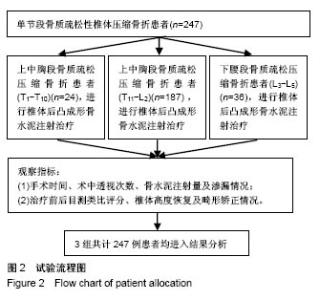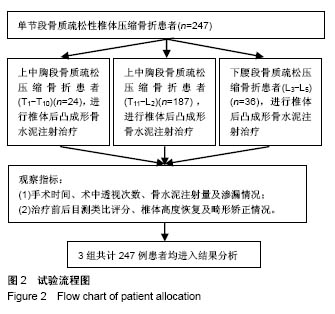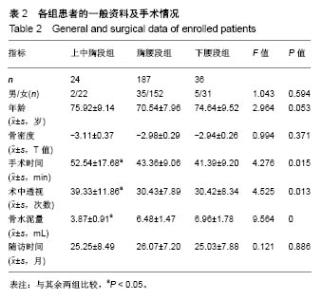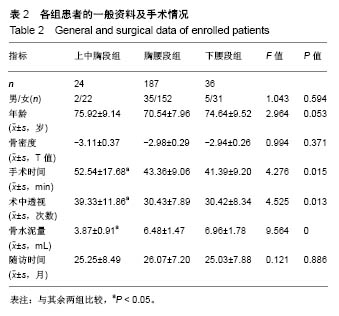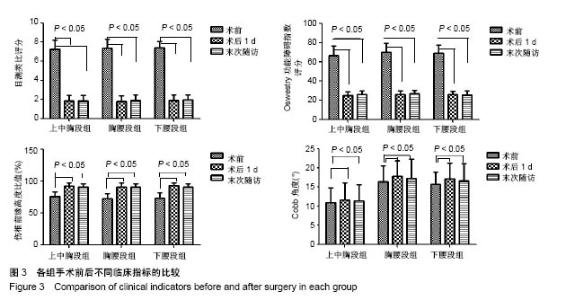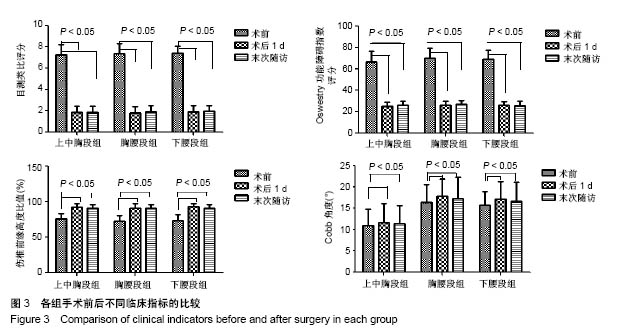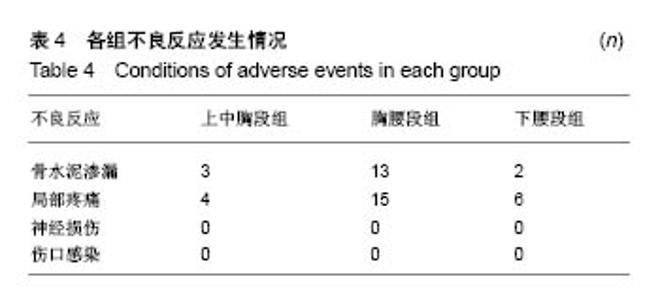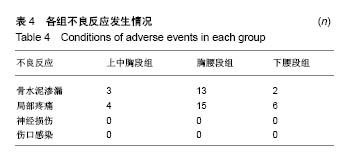Chinese Journal of Tissue Engineering Research ›› 2019, Vol. 23 ›› Issue (14): 2140-2146.doi: 10.3969/j.issn.2095-4344.1633
Previous Articles Next Articles
Kyphoplasty with bone cement injection for the treatment of osteoporotic vertebral compression fractures in different parts of the spine
Zhang Lei, Wang Lingjun, Yang Huilin, Chen Liang, Gu Yong
- Department of Orthopedic Surgery, the First Affiliated Hospital of Soochow University, Suzhou 215006, Jiangsu Province, China
-
Received:2018-12-02 -
Contact:Gu Yong, Associate chief physician, Department of Orthopedic Surgery, the First Affiliated Hospital of Soochow University, Suzhou 215006, Jiangsu Province, China -
About author:Zhang Lei, Master, Attending physician, Department of Orthopedic Surgery, the First Affiliated Hospital of Soochow University, Suzhou 215006, Jiangsu Province, China -
Supported by:the National Natural Science Foundation of China, No. 81601891 (to GY)
CLC Number:
Cite this article
Zhang Lei, Wang Lingjun, Yang Huilin, Chen Liang, Gu Yong. Kyphoplasty with bone cement injection for the treatment of osteoporotic vertebral compression fractures in different parts of the spine[J]. Chinese Journal of Tissue Engineering Research, 2019, 23(14): 2140-2146.
share this article
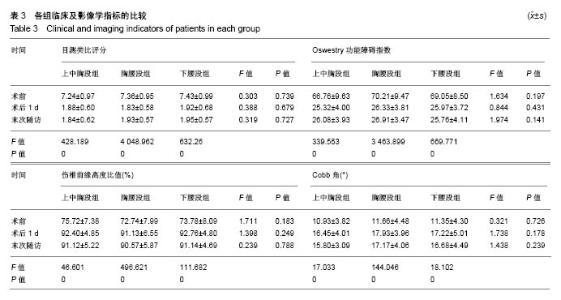
2.5.1 目测类比评分 术前、术后1 d及末次随访时,3组间目测类比评分比较差异无显著性意义(P > 0.05);3组术后1 d及末次随访时的目测类比评分均低于术前,差异有显著性意义(P < 0.05),3组末次随访时的目测类比评分与术后1 d比较差异无显著性意义(P > 0.05),见表3。 2.5.2 Oswestry功能障碍指数 术前、术后1 d及末次随访时,3组间Oswestry功能障碍指数评分比较差异无显著性意义(P > 0.05);3组术后1 d及末次随访时的Oswestry功能障碍指数评分均低于术前,差异有显著性意义(P < 0.05),3组末次随访时的Oswestry功能障碍指数评分与术后1 d比较差异无显著性意义(P > 0.05),见表3。 2.5.3 伤椎前缘高度比值 术前、术后1 d及末次随访时,3组间伤椎前缘高度比值比较差异无显著性意义(P > 0.05);3组术后1 d及末次随访时的伤椎前缘高度比值均高于术前,差异有显著性意义(P < 0.05),3组末次随访时的伤椎前缘高度比值与术后1 d比较差异无显著性意义(P > 0.05),见表3。 2.5.4 Cobb角 术前、术后1 d及末次随访时,3组间Cobb角比较差异无显著性意义(P > 0.05);3组术后1 d及末次随访时的Cobb角均高于术前,差异有显著性意义(P < 0.05),3组末次随访时的Cobb角与术后1 d比较差异无显著性意义(P > 0.05),见表3。"
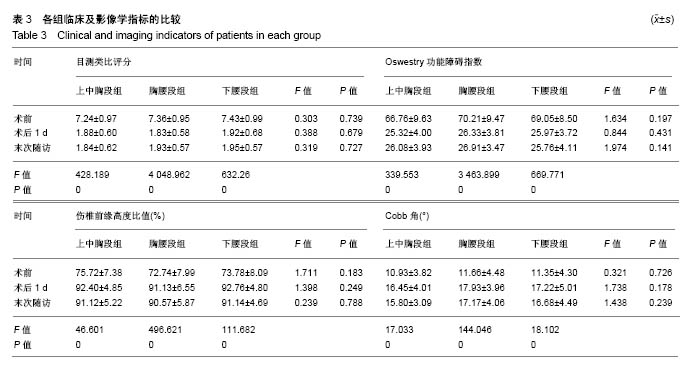
| [1] Hallberg I,Rosenqvist AM,Kartous L,et al.Health-related quality of life after osteoporotic fuactures.Osteoporos Int. 2004;15(10): 834-841.[2] Johnell O,Kanis JA,Odén A,et al.Mortality after osteoporotic fractures.Osteoporos Int.2004;15(1):35-42.[3] Eck JC,Nachtigall D,Humphreys SC,et al.Comparison of vertebroplasty and balloon kyphoplasty for treatment of vertebral compression fractures:a meta-analysis of the literature. Spine J.2008; 8(3): 488-497.[4] Korovessis P,Vardakastanis K,Vitsas V,et al.Is Kiva implant advantageous to balloon kyphoplasty in treating osteolytic metastasis to the spine? Comparison of 2 percutaneous minimal invasive spine techniques: a prospective randomized controlled short-term study. Spine (Phila Pa 1976). 2014;39(4): E231-239.[5] 王凯,李春亮,朱海勇,等.不同治疗方法减轻老年退行性骨质疏松性胸腰椎体压缩性骨折腰背部疼痛的差异:2年随访的非随机,对照临床试验方案及预试验结果[J].中国组织工程研究, 2018, 22(19):3000-3004.[6] McGirt MJ,Parker SL,Wolinsky JP,et al.Vertebroplasty and kyphoplasty for the treatment of vertebral compression fractures:an evidenced-based review of the literature.Spine J. 2009;9(6):501-508.[7] Tan HY, Wang LM,Zhao L,et al.A prospective study of percutaneous vertebroplasty for chronic painful osteoporotic vertebral compression fracture.Pain Res Manag. 2015;20(1): e8-11.[8] 杨丰建,林伟龙,朱炯,等.经皮椎体成形术和经皮椎体后凸成形术治疗骨质疏松性椎体压缩骨折[J].中国脊柱脊髓杂志, 2011, 21(1):50-54.[9] 杨惠林.科学认识椎体成形术与椎体后凸成形术的临床价值[J].中国脊柱脊髓杂志,2010,20(6):441-443. [10] 徐宝山,胡永成,闫广辉,等.经皮椎体成形术和后凸成形术的相关问题探讨[J].中华骨科杂志,2009, 29(5):430-436.[11] Bouza C,López-Cuadrado T,Almendro N,et al.Safety of balloon kyphoplasty in the treatment of osteoporotic vertebral compression fractures in Europe: a meta-analysis of randomized controlled trials.Eur Spine J.2015;24(4):715-723. [12] Schlaich C,Minne HW,Bruckner T,et al.Reduced pulmonary function in patients with spinal osteoporo tic fractures. Osteoporos Int.1998;8(3):261-267.[13] 赵丽,关继奎,杨欢.老年COPD合并胸腰椎骨折PVP术对肺功能的改善研究[J].中外医疗,2011,30(8): 22-23.[14] 黄荷,吴培玉,谢春亮.椎体强化术治疗骨质疏松性椎体骨折前后 肺功能变化及相关因素分析[J].中国矫形外科杂志, 2016,24(2): 128-132.[15] Yang HL, Zhao L, Liu J,et al.Changes of pulmonary function for patients with osteoporotic vertebral compression fractures after kyphoplasty.J Spinal Disord Tech.2007;20(3):221-225.[16] Seybold EA,Sweeney CA,Fredrickson BE,et al.Functional outcome of low lumbar burst fractures. A multicenter review of operative and nonoperative treatment of L3-L5.Spine (Phila Pa 1976).1999;24(20): 2154-2161.[17] 干旻峰,钮俊杰,朱若夫,等.经皮椎体后凸成形术治疗骨质疏松性下腰椎骨折疗效分析[J].中国矫形外科杂志, 2015,23(12): 1068-1071.[18] 王兆红,吴德慧,马超,等.双侧经椎弓根入路与单侧经椎弓根外极外侧入路在椎体成形术中的应用比较[J].中国骨伤, 2012,25(12): 975-978.[19] Ge Z, Ma R, Chen Z, et al. Uniextrapedicular kyphoplasty for the treatment of thoracic osteoporotic vertebral fractures. Orthopedics.2013;36(8):e1020-e1024.[20] Huang Z,Wan S,Ning L,et al.Is unilateral kyphoplasty as effective and safe as bilateral kyphoplasties for osteoporotic vertebral compression fractures? A Meta-analysis.Clin Orthop Related Res.2014;472(9):2833-2842.[21] 刘磊,刘光旺,马超.单侧椎弓根旁入路椎体成形术治疗下胸椎压缩性骨折的疗效观察[J].中华创伤骨科杂志, 2015,17(9): 780-785.[22] Chen C,Chen L,Gu Y,et al.Kyphoplasty for chronic painful osteoporotic vertebral compression fractures via unipedicular versus bipedicular approachment:a comparative study in early stage. Injury.2010;41(4):356-359. [23] 杨惠林,牛国旗,梁道臣,等.单球囊与双球囊后凸成形术对椎体复位作用的研究[J].中华外科杂志,2004,40(21):1299-1302.[24] Liebschner MA,Rosenberg WS,Keaveny TM.Effects of bone cement volume and distribution on vertebral stiffness after vertebroplasty. Spine (Phila Pa 1976). 2001;26(14):1547-1554.[25] 王想福,范有福,石瑞芳,等.单侧穿刺椎体后凸成形术骨水泥分布与穿刺角度的关系[J].中国骨伤,2015,8(28):704-707.[26] 申勇,刘法敬,张英泽.单、双侧经皮椎体后凸成形术治疗骨质疏松性椎体压缩骨折的疗效[J].中国脊柱脊髓杂志, 2011,21(3): 202-206. [27] Chen L, Yang H, Tang T. Unilateral versus bilateral balloon kyphoplasty for multilevel osteoporotic vertebral compression fractures: a prospective study. Spine(Phila Pa 1976).2011; 36(7):534-540.[28] Molloy S, Mathis JM, Belkoff SM.The effect of vertebral body percentage fill on mechanical behavior during percutaneous vertebroplasty.Spine(Phila Pa 1976).2003;28(14):1549-1554.[29] 崔维,刘宝戈,王磊,等.经皮椎体后凸成形术中球囊扩张体积与骨水泥注射量的相关性分析[J].中华外科杂志, 2015,53(4): 289-293.[30] Kaufmann TJ,Trout AT,Kallmes DF.The effects of cement volume on clinical outcomes of percutaneous vertebroplasty. AJNR Am J Neuroradiol. 2006;27(9):1933-193[31] 徐磊,杨惠林,姜为民,等.单侧经皮聚甲基丙烯酸甲酯骨水泥椎体成形治疗中骨水泥注入位置、注入量与疗效的相关性[J].中国组织工程研究,2018,16(21):3833-3837.[32] 杨惠林,Hansen A Yuan,陈亮.椎体后凸成形术治疗老年骨质疏松脊柱压缩骨折[J].中华骨科杂志,2003,23(5):262-265.[33] 邹德威,马华松,邵水霖,等.球囊扩张椎体后凸成形术治疗老年骨质疏松脊柱压缩骨折[J].中华骨科杂志,2003,23(5):257-261.[34] Chen L,Dong R,Gu Y,et al.Comparison between Balloon Kyphoplasty and Short Segmental Fixation Combined with Vertebroplasty in the Treatment of Kümmell's Disease.Pain Physician.2015;18(4): 373-381.[35] Hadjipavlou AG,Tzermiadianos MN,Katonis PG,et al. Percutaneous vertebroplasty and balloon kyphoplasty for the treatment of osteoporotic vertebral compression fractures and osteolytic tumours. J Bone Joint Surg Br. 2005;87(12): 1595-1604.[36] Hulme PA,Krebs J,Ferguson SJ,et al.Vertebroplasty and kyphoplasty:a systematic review of 69 clinical studies.Spine(Phila Pa 1976).2006,31(17):1983-2001.[37] Georgy BA.Clinical experience with High-Viscosity cements for percutaneous vertebral body augmentation: occurrence, degree, and location of cement leakage compared with kyphoplasty.Am J Neuroradiol.2010;31(3):504-508. [38] 杨森,徐韬,盛伟斌,等.单双侧球囊灌注骨水泥椎体成形修复骨质疏松性椎体压缩骨折的系统评价[J]. 中国组织工程研究, 2015, 19(8):1306-1312.[39] Xie W,Jin D,Ma H,et al. Cement leakage in percutaneous vertebral augmentation for osteoporotic vertebral compression fractures: analysis of risk factors.J Spinal Disord Tech. 2016; 29(4):E171-176. |
| [1] | Zhang Tongtong, Wang Zhonghua, Wen Jie, Song Yuxin, Liu Lin. Application of three-dimensional printing model in surgical resection and reconstruction of cervical tumor [J]. Chinese Journal of Tissue Engineering Research, 2021, 25(9): 1335-1339. |
| [2] | Zeng Yanhua, Hao Yanlei. In vitro culture and purification of Schwann cells: a systematic review [J]. Chinese Journal of Tissue Engineering Research, 2021, 25(7): 1135-1141. |
| [3] | Xu Dongzi, Zhang Ting, Ouyang Zhaolian. The global competitive situation of cardiac tissue engineering based on patent analysis [J]. Chinese Journal of Tissue Engineering Research, 2021, 25(5): 807-812. |
| [4] | Wu Zijian, Hu Zhaoduan, Xie Youqiong, Wang Feng, Li Jia, Li Bocun, Cai Guowei, Peng Rui. Three-dimensional printing technology and bone tissue engineering research: literature metrology and visual analysis of research hotspots [J]. Chinese Journal of Tissue Engineering Research, 2021, 25(4): 564-569. |
| [5] | Chang Wenliao, Zhao Jie, Sun Xiaoliang, Wang Kun, Wu Guofeng, Zhou Jian, Li Shuxiang, Sun Han. Material selection, theoretical design and biomimetic function of artificial periosteum [J]. Chinese Journal of Tissue Engineering Research, 2021, 25(4): 600-606. |
| [6] | Liu Fei, Cui Yutao, Liu He. Advantages and problems of local antibiotic delivery system in the treatment of osteomyelitis [J]. Chinese Journal of Tissue Engineering Research, 2021, 25(4): 614-620. |
| [7] | Li Xiaozhuang, Duan Hao, Wang Weizhou, Tang Zhihong, Wang Yanghao, He Fei. Application of bone tissue engineering materials in the treatment of bone defect diseases in vivo [J]. Chinese Journal of Tissue Engineering Research, 2021, 25(4): 626-631. |
| [8] | Zhang Zhenkun, Li Zhe, Li Ya, Wang Yingying, Wang Yaping, Zhou Xinkui, Ma Shanshan, Guan Fangxia. Application of alginate based hydrogels/dressings in wound healing: sustained, dynamic and sequential release [J]. Chinese Journal of Tissue Engineering Research, 2021, 25(4): 638-643. |
| [9] | Chen Jiana, Qiu Yanling, Nie Minhai, Liu Xuqian. Tissue engineering scaffolds in repairing oral and maxillofacial soft tissue defects [J]. Chinese Journal of Tissue Engineering Research, 2021, 25(4): 644-650. |
| [10] | Xing Hao, Zhang Yonghong, Wang Dong. Advantages and disadvantages of repairing large-segment bone defect [J]. Chinese Journal of Tissue Engineering Research, 2021, 25(3): 426-430. |
| [11] | Chen Siqi, Xian Debin, Xu Rongsheng, Qin Zhongjie, Zhang Lei, Xia Delin. Effects of bone marrow mesenchymal stem cells and human umbilical vein endothelial cells combined with hydroxyapatite-tricalcium phosphate scaffolds on early angiogenesis in skull defect repair in rats [J]. Chinese Journal of Tissue Engineering Research, 2021, 25(22): 3458-3465. |
| [12] | Wang Hao, Chen Mingxue, Li Junkang, Luo Xujiang, Peng Liqing, Li Huo, Huang Bo, Tian Guangzhao, Liu Shuyun, Sui Xiang, Huang Jingxiang, Guo Quanyi, Lu Xiaobo. Decellularized porcine skin matrix for tissue-engineered meniscus scaffold [J]. Chinese Journal of Tissue Engineering Research, 2021, 25(22): 3473-3478. |
| [13] | Mo Jianling, He Shaoru, Feng Bowen, Jian Minqiao, Zhang Xiaohui, Liu Caisheng, Liang Yijing, Liu Yumei, Chen Liang, Zhou Haiyu, Liu Yanhui. Forming prevascularized cell sheets and the expression of angiogenesis-related factors [J]. Chinese Journal of Tissue Engineering Research, 2021, 25(22): 3479-3486. |
| [14] | Liu Chang, Li Datong, Liu Yuan, Kong Lingbo, Guo Rui, Yang Lixue, Hao Dingjun, He Baorong. Poor efficacy after vertebral augmentation surgery of acute symptomatic thoracolumbar osteoporotic compression fracture: relationship with bone cement, bone mineral density, and adjacent fractures [J]. Chinese Journal of Tissue Engineering Research, 2021, 25(22): 3510-3516. |
| [15] | Liu Liyong, Zhou Lei. Research and development status and development trend of hydrogel in tissue engineering based on patent information [J]. Chinese Journal of Tissue Engineering Research, 2021, 25(22): 3527-3533. |
| Viewed | ||||||
|
Full text |
|
|||||
|
Abstract |
|
|||||
